|
When sunrays crown thy pine-clad
hills
And summer spreads her hand
When silvern voices tune thy rills
We love thee, smiling land
We love thee, we love thee, we love
thee Newfoundland.
When spreads thy cloak of shimm’ring
white,
At Winter’s stern command,
Thro’ shortened day and starlit night,
We love thee, frozen land,
We love thee, we love thee, we love
thee, frozen land.
When blinding storm-gusts fret thy
shore
And wild waves lash thy strand
Thro’ spindrift swirl and tempest roar
We love thee, windswept land
We love thee, we love thee, we love
thee windswept land.
Newfoundland anthem, Sir Cavendish Boyle
My first impression of
North America was to be in the Province of Newfoundland and Labrador. It
proved to be an enriching experience in many ways despite the Province
being the butt of many jokes on the Canadian mainland. I recall the
words of a Canadian couple I spoke to in Prestwick airport Scotland, as
I waited for my flight to depart in October 1965. They said “oh,
Newfoundland, - the cold, the mist, the snow, the parochialism, the
isolation, - and we can assure you, - you will love it!” They were
absolutely right. ‘Newfy’s’ make up for all the disadvantages of their
island community with a wonderful spirit of friendliness, humour, love
of music, openness and hospitality.
Mainland Canadians are
surprisingly ignorant of Newfoundland which is in many ways more
cultured and better developed than some parts of the other maritime
provinces. Eskimo and Indian peoples inhabited the area for many
centuries, and there appear to have been brief settlements of Viking
sailors in pre-Columbus times, though evidential remains are scanty.
The first recorded European visitor was in 1498, when John Cabot of
Bristol arrived (or was he Jean Cabot of France? or Giovanni Cabotto of
Italy! – it is not certain). So that part of Canada has been exposed to
European fishers and traders for over 500 years. Newfoundland was
proclaimed an English colony under Queen Elizabeth 1st in 1583 by Sir
Humphrey Gilbert, but that ill-fated explorer lost his life on the
return voyage across the Atlantic. Cornish and west English fishers
began to establish stations on Newfoundland’s east coast from the 17th
century. The British Government was not keen however to see an
indigenous fishing industry established, since it would compete with
English merchants, and for many years, each autumn, the British navy
burnt settlements established near the shore by fishers who may have had
visions of spending the winter there. See St John’s magnificent harbor
below :
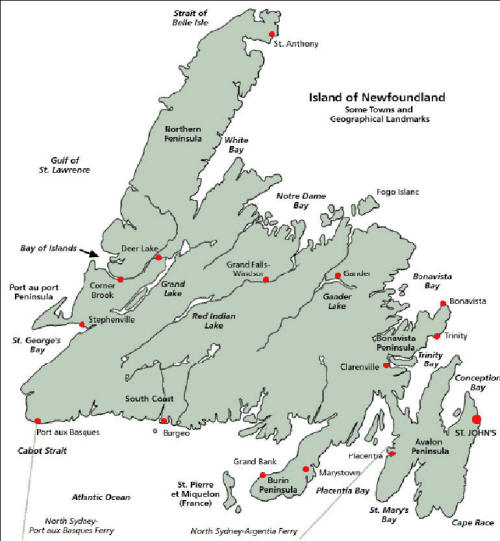
map of Newfoundland
When I arrived, Portuguese sailing schooners were still
fishing for cod in the summer months. These beautiful vessels often
came into St. John’s harbour where they were a colourful sight.
American and Canadian dory fishing had all but ceased, but those
intrepid Portuguese sailors went off from their schooners in little
one-man and two-man dories, hand-lining for cod on the Greenland
grounds. The fish caught were split and salted, and taken back to
Portugal to be further dried and sold as stockfish. The type of fishing
was described by Rudyard Kipling in Captains Courageous, and
pictured in the Spencer Tracy film of that novel. Cod fishing by
Newfoundland fishers in the 1960’s was by means of the cod trap, a
box-shaped net with a short leader, set next to the shore or cliffs, or
by baited long-line, or otter trawl. Some old British side trawlers had
been procured by local companies, and a fleet of new steel stern
trawlers was being steadily built up.

Newfoundland dory (used
for cod fishing) St Johns natural harbour
The famous Grand Banks
of Newfoundland were already fished out by the 1960’s, and cod stocks
had moved to the north-west and north-east. Some fishers and scientists
believe that the current absence of cod off Canada’s east coast owes
more to global warming of sea temperatures, and to the cod seeking
colder waters, than to over-fishing by local fleets which was the
government’s conclusion. But in the 1960’s though cod were still
around, they were mostly found off Labrador to the north. During the
spawning season however some schools still entered the Newfoundland bays
where many were still trapped in the local fish traps set for that
purpose.
Farther north, the larger and sparsely populated part of the
Province, was wild Labrador, where Newfy sealers went to fish each
winter or spring. This remote and forbidding land was the scene of the
life’s work of Dr William Grenfell, a remarkable missionary and
pioneer. He had served with the British RNMDSF fishermens mission on
the North Sea in the late 1880’s but heard that a greater challenge and
greater needs existed in Labrador. So Grenfell took up the call, and so
served that province and its people, that today no name is more revered
in Labrador, than that of the humble, persevering doctor.

postage stamp of Sir Wilfred Grenfell
Dr Grenfell and his Labrador mission boat
I lodged with a local
family the first
year, in the appropriately named Topsail Road, and enjoyed
a rich fare of home-baked bread, local berries, and meat from moose,
rabbit, seal, seabird and whale. The seal and whale meats were too
strong for me, but the ‘flipper pie’ was palatable. Surprisingly fish
were not often on the menu. In the 1960’s there was not a single fresh
fish market in St. John’s, only the occasional sale of cod from a
wheelbarrow in Water street, by fishers from the nearest cove. And the
frozen fillets of cod, flounder and redfish from local fish plants were
abominable to say the least.
Newfoundland had a
thriving stockfish (dried, split, salted cod) trade up till 1960, for
which there was and is a ready market. The most lucrative market was in
the Iberian peninsula, the next in West Africa, and the lowest quality
went to the Caribbean. Some bright fishery administrator abolished the
quality grading of stockfish. The general quality then bottomed out,
and at times was not even acceptable on the cheapest markets. For all
its fishing history, the Province’s industry of that period, was in a
dismal condition, which was one reason the Fishery College was built,
and I was offered work there for two years.
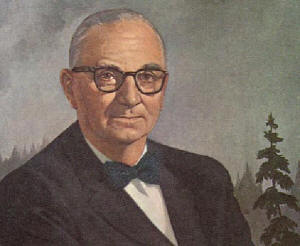 Newfoundland
then had a dynamic Premier, Joey Smallwood, who had great vision for his
Province having fought successfully for it to undertake the step of
Confederation with Canada. He was constantly on the lookout for new
investment and new industry. But like many isolated island communities,
Newfoundland was regularly taken advantage of by fast-buck merchants and
pretending investors who had other agendas. One of the biggest
disappointments was the Churchill Falls hydro-power dam in Labrador.
The project was planned during my stay, and came on stream just before
the OPEC oil crisis and the global rise in energy prices. The Province
found itself locked into a contract by Quebec that gave it so little in
return for the electricity, Newfoundland was actually subsidizing the
richer mainland provinces with valuable energy. Above left :Joey
Smallwood, Newfoundland’s dynamic Premier Newfoundland
then had a dynamic Premier, Joey Smallwood, who had great vision for his
Province having fought successfully for it to undertake the step of
Confederation with Canada. He was constantly on the lookout for new
investment and new industry. But like many isolated island communities,
Newfoundland was regularly taken advantage of by fast-buck merchants and
pretending investors who had other agendas. One of the biggest
disappointments was the Churchill Falls hydro-power dam in Labrador.
The project was planned during my stay, and came on stream just before
the OPEC oil crisis and the global rise in energy prices. The Province
found itself locked into a contract by Quebec that gave it so little in
return for the electricity, Newfoundland was actually subsidizing the
richer mainland provinces with valuable energy. Above left :Joey
Smallwood, Newfoundland’s dynamic Premier
The College of
Fisheries, Navigation, Marine Engineering and Electronics, was one of
Premier Smallwood’s projects. It was housed in the former Memorial
University buildings when that institute moved to a new campus. The
main building appears in an earlier Newfoundland postage stamp issued
before Confederation with Canada. President of the College was Dr W. F.
(Bill) Hampton, a former food technologist who was credited with
development of the first “fish fingers”. There were both national and
international staff in the five college departments. Two of my
colleagues in Nautical Science were marvelous seamen, - former masters
of schooners, Captain Williams and Captain Burden. Captain Williams’
seamanship room was one of the finest I have seen anywhere, with
examples of every kind of rope-work, wire-work and ship’s rigging. My
direct co-lecturer was Professor Yunosuke Iitaka from Kinki Unuversity,
Osaka, Japan. He was a splendid example of the fishery academics
produced by the then leading fishery country in the world.
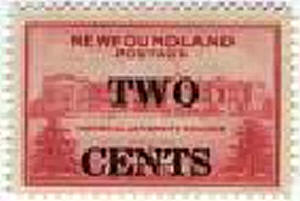
Postage stamp showing the old Memorial University in St John’s which
became the new College of Fisheries in 1964. (The College was later
moved and was transformed into a new Marine Institute. The old building
now houses a technical school)
A fascinating staff
member in our Department was Otto Kelland, a well-known local musician
and song-writer. The college had hired him for his skills in making
model boats, but he was more renowned for his musical talents. All who
know Newfoundland will be aware of its rich heritage of sea shanties and
folk songs, mostly with an Irish lilt to them. Otto’s finest production
was Cape St. Mary’s, written in 1945. The music which is
truly moving, you will have to locate elsewhere, but I cannot resist the
temptation to include a few verses here.
Take me back to my western boat, let me fish
off Cape St. Mary’s
Where the hag-downs sail, and the fog-horns
wail,
With my friends the Browns and the Cleary’s,
Let me fish off Cape St. Mary’s.
Let me feel my dory lift, to the broad Atlantic combers
Where the tide rips swirl and wild ducks whirl.
Where old Neptune calls the numbers
‘Neath the broad Atlantic combers.
Let me sail up Golden Bay, with my oilskins all astreamin’
From the thunder squall when I hauled my trawl
And my old Cape Anne a-gleamin’,
And my oilskins all a-streamin’.
Let me view that rugged shore, where the
beach is all a-glisten
With the capelin spawn, where from dusk to dawn,
You bait your trawl and listen,
To the undertow a-hissin’.
Take me back to that snug green cove, where
the seas rolls up their thunder,
There let me rest in the earth’s cool breast
Where the stars shine out their wonder
And the seas rolls up their thunder.
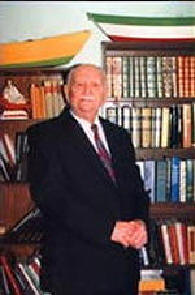
Otto Kelland the composer of Cape St.
Mary’s who died in his hundredth year. He made beautiful models of
schooners and fishing boats for the College when I served there.
Newfoundland had its
“city” people and its “bay” people, and you had not arrived till you had
stayed a few days in one of the many out-ports where houses were mostly
built on pole frames above the ground. Practically every second
Newfoundlander then was a skilled carpenter and could build a timber
frame house, as his wife could bake bread. (No self-respecting
Newfoundland wife would buy bread, - only flour. Bread was what
incomers and some city people bought!). To spend a week-end at an
outport was to experience generous hospitality and friendship. The food
was plentiful and varied, with some moose and caribou occasionally
served. My young wife found the heart meat a bit revolting to her mind
– it tasted great till she she was told what it was! Then she asked to
use the toilet and was shown into a bedroom. When she protested that it
was a bathroom she needed, she was shown a bucket in the corner!
Bathrooms were luxuries few outport houses possessed then.
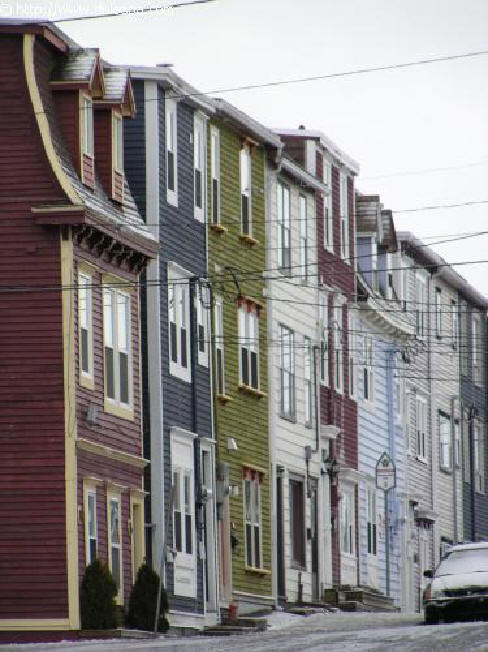
Old houses in a St John’s street
The capelin run was an
exciting annual event that brought most of us to one of the local
beaches to witness. Those anchovy-like fish swam inshore and spawned in
schools on the shore. They would swim on to the beach in threes – two
males and a female – and deposit their spawn and sperm on the pebbles or
gravel. They made an excellent dish when fried fresh. To me the
nearest fish in taste and shape to the capelin, are the slightly larger
flying fish which we used to catch and eat in the Pacific and Indian
oceans.
The open moorlands of
Newfoundland were briefly covered in berries late summertime. There were
different sorts, but to collect any you had to be quick as the season
was very short. I sometimes wondered if the Viking name of “Vinland”
for the island, was a reference, not to grapes as widely assumed, but to
the berries that abound for part of the year. I doubt if wild grapes
could have survived that far north in the past thousand years.
At the beginning of my
second year in the new world, I flew home to marry my Scots sweetheart.
On the way home I changed planes at Gander airport where I literally
bumped into Prime Minister Harold Wilson in the bookshop. He was on his
way to Washington to seek financial help for Britain’s ailing economy
from President Johnson. (He obtained the assistance, but it effectively
silenced him from voicing any further objections or concerns about the
Vietnam war). However, to happier things, - we set up home in a cosy
new wooden bungalow at the edge of the woods behind the north-west side
of the city of St. John’s. It was typical of the Newfy people that they
gave us a second wedding reception on our arrival. Our first year of
wedded bliss was unalloyed by the sub-zero temperatures and severe
snowstorms that continued through the long winter.
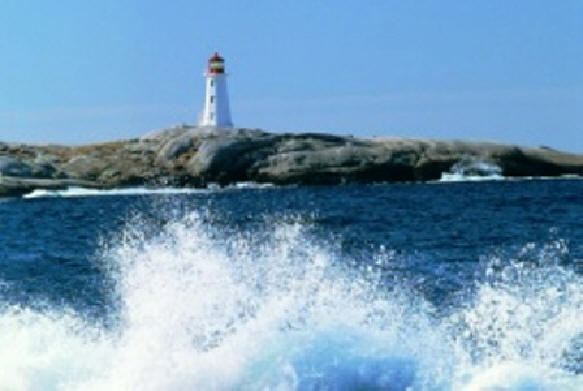
Newfoundland Scenes
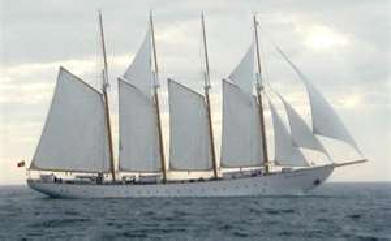
Portuguse schooner
St. John’s has a fine large natural harbour protected by high
rocky land on either side of the narrow entrance. The promontory on the
north side of the entrance is known as “Signal Hill” as it was from
there in December 1901 that Guglielmo Marconi received the first
trans-Atlantic radio signal, - the letter “S” transmitted repeatedly
from a station in Cornwall, and received by an aerial wire held aloft
with a kite. On the same side of the
harbour is the site of a former military defense battery. I have
stood on Signal Hill when the harbour was frozen over, and the ice
extended 3 miles seaward. A trawler was caught in the ice half a mile
away, and its crew had been able to walk ashore.
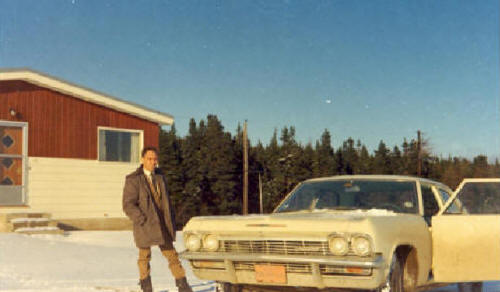
Above : Outside our first home in St.
John’s, Newfoundland
We visited Signal Hill
and the Battery often, and my young wife celebrated her 21st
birthday in the battery restaurant over-looking the harbour. We were to
return for a reunion dinner 21 years later, and were joined by the same
lovely Newfoundland couple who were with us on the first occasion.
Bertha hailed from Red Bay in Labrador, and she often related how life
was growing up on that remote coast. Bob had worked for the Hudson Bay
trading company as a young man, and had equally interesting tales to
tell.
A Mrs Betty Adams from
Edinburgh, who used to be a customer of my wife’s parents fruit and
vegetable shop in Morningside, became a trusted friend. Her
Newfoundland husband, Charles, was a fine member of a notable local
family who were active in fuel supplies and distribution, and in
politics. Bill Adams, a lawyer, was then running for Mayor of St.
John’s, a position he won and held with distinction. They were typical
of the fine town people of the Province. Our departmental secretary at
the College, Margaret Hiscock, became a close friend. She went on to
become secretary to a subsequent Premier of Newfoundland, Brien Peckford.
I had met Joey Smallwood during his tenure, and knew his successor,
Frank Moores when he was managing a fish plant in Carbonear. When
Newfoundland joined the Canadian Federation in 1949, it was (in the
words of a Newfoundlander I knew), “a poverty-stricken hole” with a
population of 300,000, and 52 millionaires who had mostly made their
money from the fishing industry, amplifying it later by obtaining the
franchise or dealership for heavy equipment and other manufactured
goods.
I visited mining towns
in central Newfoundland, and stayed with families who lived in
“tar-paper shacks”, - small houses made of tar-coated, insulated
cardboard sheets nailed over a simple wooden frame. Those mining
settlements were rather depressing. The company controlled everything,
and if a resident fell into disfavour, his or her future there was bleak
indeed. On the west coast there were some poor French-speaking
communities, some of whose unemployed men sometimes attended vocational
courses at the college. We also had a few students of Eskimo origin
attend from Labrador.
I recall a meeting with
small scale fishers near Corner Brook where they were berated by Fishery
Officials for their lack of enterprise. They sat there meekly, taking
it it all in silence, and leaving it to their parish priest to speak for
them. Towards the end of the meeting, being young and a bit too
outspoken, I expressed strong disagreement with the attitude of the
officials who seemed to think the poor fishers should lift themselves up
by their bootstraps. I urged the speakers to look at things from the
situation of the powerless and vulnerable community, and opined that a
much more effective and realistic development programme was needed. The
statement brought an immediate response from the silent fishers who
suddenly broke into into a spontaneous burst of loud applause. It was
then the turn of the officials to maintain a stony silence. Many years
later I was invited by Simon Fraser University to participate in a
community workshop for the residents of the Change Islands, - a small
isolated community on that tiny rocky location situated between the
northern tip of Newfoundland and the coast of Labrador.
Other parts of Canada
we visited, apart from all of the eastern maritime states, were Ontario
(of course, - where most Scots immigrants gravitated to), Quebec, and
British Columbia. My older brother, a civil engineer, and his family
had settled in Toronto, after working some years in Nova Scotia, on the
construction of the Cabot Trail and the Trans-Canada Highway. Billy was
a fine amateur golfer, and won several trophies in competitions held in
Nova Scotia and Ontario. From Toronto we drove to Ottawa to visit
friends we knew in Rome, and to attend an interesting session of the
Canadian Parliament. In Vancouver, I had lovely relatives in a
half-sister of my mother, and her two lovely daughters. Aunt Nell, at
over 80, still stood ramrod straight, and had a sharp intellect and an
enquiring mind. She had been a real pioneer in the Yukon territory
during the 1920’s and 1930’s.
Whenever I think of the
Yukon territory and the klondyke days, my mind goes back to a second
generation Scot, a writer, who worked for the Canadian Bank of Commerce
in some of the wild Yukon territory outposts like Whitehorse and
Dawson. He painted the characters and life of the frontier fortune
hunters, in marvelous verse. I refer to Robert Service. Readers will
know who I mean the minute I quote the titles of some of his works :
the Shooting of Dan McGrew; the Creation of Sam McGee; the Law
of the Yukon; the ballad of One-eyed Mike; Once I found his book
“Songs of a Sourdough”, and the various collections of his verse, I
could not resist putting them to memory, and reciting them to friends on
the odd occasion when a social evening was getting dull.
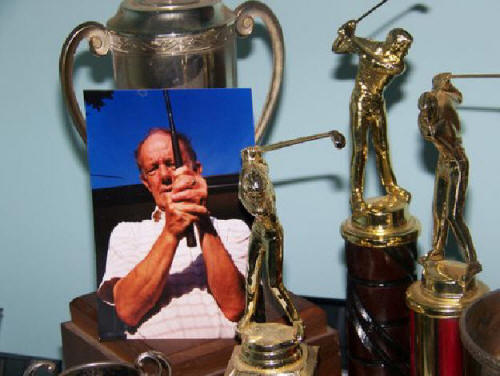
Picture of my late brother Billy with
several of the golf trophies he won in Canada.
The Yukon and Rocky
Mountain range also bring to mind the work of an English-born explorer
of that region, - a namesake of mine. Along with the Lewis born Scot,
Alexander MacKenzie, David Thompson ranks as one of the premier
explorers and surveyors of North America. He was born in England in
1770 of a Welsh father who died when David was an infant. At the
amazingly early age of 14, he sailed to Canada as an apprentice to the
Hudson Bay Company at their Churchill station. He was to develop great
skills as a surveyor, and was to take considerable interest in the
native Indian populations. Dissatisfied with his work as a fur trader,
he joined the North West Company on Lake Superior in 1797. For the next
20 years and more, Thompson was to explore and map most of North West
America, including the border between the USA and Canada. Simon Fraser
was to name the Thompson river after him. (see box below).

Above : Robert Service the great poet of
the Yukon and the Canadian west
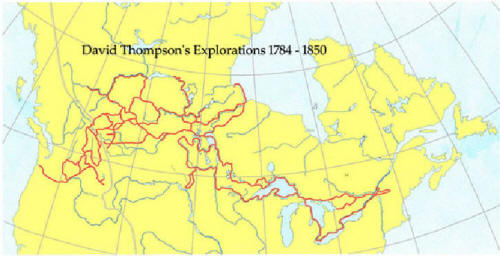
Above : map of David Thompson’s
explorations
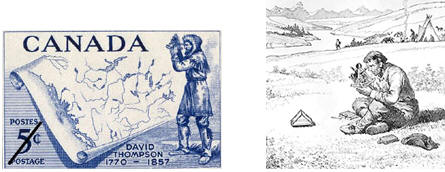
postage stamp of
Thompson Thompson surveying
|
A remarkable explorer and geographer
A west Canadian mountain
peak and river, are rightly named after a remarkable explorer
who surveyed and mapped these immense areas when working for fur
trading companies in north and north-west America. David
Thompson had arrived in Canada as a young teenager. He quickly
took a deep interest in the land and its people. At the age of
eighteen he was tutored by Philip Turnor, an astronomer and
surveyor employed by the Hudson Bay Company. That appears to
have been the extent of Thompson’s formal scientific education,
and in many ways he resembles the great 18th century navigator,
James Cook, who was also largely self-taught.
His skill and travels are
all the more remarkable when one considers that an early
accident left him blind in one eye and limping from a leg
fracture. He persuaded the trading company to furnish him with
a compass, watches, thermometers, sextant, an artificial
horizon, and nautical almanacs. He was to explore and chart
much of northern Manitoba and Saskatchewan, the Missouri river,
and the great lakes. His greatest journey was a pioneering trek
across the Rocky Mountains and down the Columbia river to the
Pacific coast. No photograph of him exists, but his
contemporaries recalled his character. He never used alcoholic
liquor. He was marked by stubborn honesty strengthened
by steadfast and earnest devotion to simple religious
principles.
In 1812 Thompson was
appointed to the commission that surveyed the border between
Canada and the United States. His work was accepted and remains
the authoritative basis of the border to this day. The merged
companies of Hudson Bay and Northwest treated his work with
indifference, and had his maps published without credit to their
cartographer. He died in obscurity, in Montreal in 1857, by all
accounts, blind and penniless. It was to be 50 years later
before a monument was erected over his grave, in tribute to the
splendid achievements of the man who traveled fifty-five
thousand miles on foot, horseback, sleigh and canoe, and who
mapped 1,900,000 square miles of north-west Canada, and much of
the USA north-west. |
Scots featured
prominently in Canada’s history. Alexander MacKenzie, mentioned above,
was a fur trapper with the Northwest Company (which later amalgamated
with the Hudson Bay Company). He gave his name to the Mackenzie river
which he explored for most of its 3,000 miles from lake Athabasca in
Alberta, up into the Arctic ocean. Then he crossed the Rockies to the
Pacific coast, accomplishing that feat ten years before the famed Lewis
and Clark expedition. These wilderness travels took place between 1789
and 1793. After the Northwest Company merged with the Hudson Bay
Company, it was governed by a redoubtable west highland Scot, George
Simpson, who among his several eccentric habits would take a piper with
him to play pibrochs as they sailed over remote rivers and lakes.
With the passing of the
British North America Act, Canada gained Independence from Britain in
1867. This measure was achieved in large part by John MacDonald who
emigrated at an early age with his parents and who worked and struggled
to acquire a Law degree in Ontario. This later led him into politics,
and leadership of the Liberal-Conservative Party through which he sought
to build bridges with the French settlers in Quebec and New Brunswick,
and gain their support for the independence arrangements. He went on to
become the united territory’s first Prime Minister.
Another remarkable Scot
was Sandy Fleming, the chief engineer behind the 3,700 mile Canadian
Pacific Railway which was completed in 1885. The railway track’s
mountainous terrain with its many rivers and gorges were as challenging
as any team of surveyors and engineers had ever faced. But Fleming went
on to tackle another problem in an even more significant way. In the
late 19th century, in most parts of the world, clocks were
set by sunrise and sunset, and there were few places outside of Britain
that used a standard time. Simpson, who needed a common time for all
railway clocks across Canada, solved the difficulty by dividing the
world into 20 time zones of 15 degrees longitude each, and had the
scheme accepted at an international conference in Washington in 1882.
Global time was synchronized and commenced the following year.
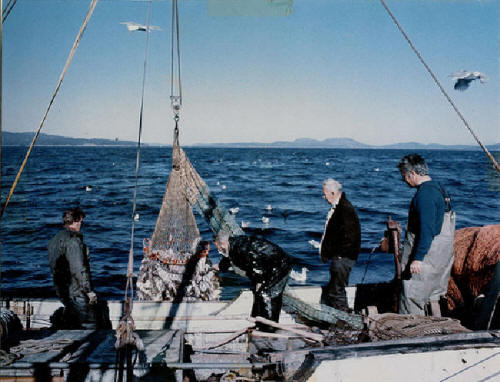
my father introducing pair seining to the
Canadian Maritimes
In addition to the
notable Canadians of Scots origin, there were of course, thousands of
emigrants and settlers from that land. Some arrived out of the distress
of the potato famine, and from the cruel Highland Clearances, but many
others arrived simply seeking opportunity in the new land. Orcadians
were prominent in the Hudson bay Company which some joked they joined to
seek a warmer change from the cold winds of Orkney. Ontario, even more
than Nova Scotia, was replete with Scots or folk of Scots descent.
Vancouver also had a large Scots community till they were swamped by
immigrants from across the Pacific. My Aunt Nell was one of those who
left Morayshire to work in the wild frontier of the Yukon trail, later
settling in Vancouver with her family.
Two very contrasting
Scots-Canadian figures of the 20th century, that have long
fascinated me, were Baron Lord Tweedsmuir, better known as the author
John Buchan, and Malcolm MacDonald, son of Ramsay MacDonald. John
Buchan was Governor General of Canada from 1935 to 1940, while Macdonald
was British High Commissioner for the country from 1941 to 1946. Though
both men were well-travelled, held several public offices, and wrote a
number of books, they were very different in character and attitude.
One, the son of a Prime Minister was remarkable for his lack of
self-importance. The other, a ‘son of the manse’, exhibited some traits
of the aristocratic class of his time

Above Left: Malcolm Macdonald British High Commissioner for Canada.
Right : John Buchan (Lord Tweedsmuir) Governor General of Canada.
Malcolm MacDonald who had been a Minister in pre-war and wartime British
Governments also held a number of Governship positions in Africa, Asia
and the Far East, but would not accept any of the titles that were
offered to him. The Foreign and Colonial offices tried to persuade him
to accept a knighthood or lordship on the grounds that huge important
countries like India and Canada would not be impressed by a plain
“Mr.”. Well, plain Mr. MacDonald was not impressed with the argument!
By all accounts he performed well in each of the positions he held, and
went on to undertake substantial preparatory work for the process of de-colonisation
that was beginning after the war. The books he wrote mostly concern his
experiences in the countries he helped to govern in south Asia and
Africa
John Buchan was 26
years older than MacDonald. He saw service in the first world war, and
like many writers of espionage tales, was for periods involved in
intelligence work. He was a “son of the manse” as we say in Scotland of
those whose fathers were Church of Scotland ministers. Had he not held
high public office, Buchan would still have been very famous for his
novels. But being Governor General of Canada added to his reputation,
and at one time his picture appeared on the front cover of Time
magazine.
But for me, it is the
novels he wrote that reveal the more fascinating side to the man. They
are strange books in some ways, - perhaps a bit like the novels of
Jeffrey Archer. They are replete with the most unbelievable
coincidences, - so bizarre and unlikely, that you almost shake your head
in disbelief and laughter at them. Yet, - there is something about his
simple tales of political intrigue and adventure, - that once you start
reading, you cannot stop till you reach the final page. At least that
is how it is for me. Yet the stories, like The 39 Steps,
Greenmantle, Island of Sheep, Mr Standfast, and Prester John,
also say something about Lord Tweedsmuir’s personal attitudes. He
often wrote in the first person, and you get glimpses of an attitude
towards foreign countries, union workers, social classes, and the status
quo, that is decidedly and self-righteously bourgeois. So one could not
conceive a greater contrast with Mr Malcolm MacDonald, the son of
Britain’s first Labour Prime Minister! Yet
I was reliably informed by a grand-daughter of Ramsay MacDonald’s, and
niece of Malcolm, that the two got on extremely well, with Lord
Tweedsmuir showing Malcolm much friendship and respect.
Canada even had a mountain named after Ramsay MacDonald’s eldest
daughter in 1956. The magnificent Mount Ishbel lies in the part of the
Rocky Mountain range within Banff National Park, in Alberta. The view of
Mount Ishbel below is as it appears from the Bow Valley Parkway.
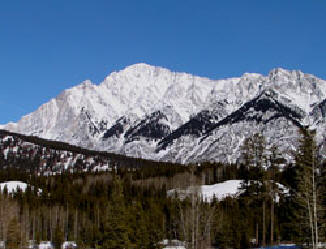
Canada today still
remains a young man’s (or young woman’s) country. It is fresh, clean,
friendly, and has enormous wide-open spaces. During my time there you
could drive along the Trans Canada highway for hours, and see very few
other vehicles. The vast forests and prairies, the magnificent Rocky
Mountains, the rugged east coast and the scenic Pacific coast, - all
combine to make Canada one of the most beautiful and environmentally
pleasant countries in the world. If Canada has a drawback, it is the
severely cold winter residents must endure. The low temperatures are
experienced mainly in central, mid-west and maritimes Canada, but to a
lesser degree along the Pacific coast. I have known several British
immigrants who loved their new adopted land, but who had increasing
difficulty in enduring the long cold winters as they grew older.
The ethnic mix in
Canada has changed enormously in the past few decades, mainly due to
enormous immigration into British Columbia from the Far East and south
Asia. Rather like Honolulu, but to a greater degree, Vancouver has
become an ethnically ‘Asian city’. In the past 300 years, English
people dominated in most provinces, with French in Quebec and New
Brunswick, and patches of Scots in Nova Scotia, Ontario and British
Columbia. Italian and German immigrants have gravitated to Ontario, and
there are smaller groups of Caribbean people in the east of the country.
Canada suffers a bit as
the ‘little brother’ to the big USA, and is regularly treated so by
American administrations. They want its fresh water, its oil and gas,
and its markets for the products of America’s huge industries. But the
relationship often appears to be much too one-sided for most Canadians,
and in this they are probably correct. As I have opined elsewhere, the
United States believes in free trade only when it suits her. When the
trade is seen as damaging to U.S. domestic interests they do not
hesitate to twist the rules. Political pressures are also put on Canada
to support US foreign policies, but for the most part the country has
been able to resist them.
What better to end my
scattered thoughts and recollections on the magnificent land of Canada,
than with a few verses from the pen of Robert Service:
I am the land that listens, I am the land
that broods;
Steeped in eternal beauty, crystalline waters
and woods.
Long have I waited lonely, shunned as a thing
accursed,
Monstrous, moody, pathetic, the last of the
lands and the first;
Visioning camp-fires at twilight, sad with a
longing forlorn,
Feeling my womb o’er-pregnant with the seed of
cities unborn.
Wild and wide are my borders, stern as death is my sway,
And I wait for the men who will win me - -
and I will not be won in a day.
And I will not be won by weaklings, subtle,
suave and mild,
But by men with the hearts of Vikings,
and the simple faith of a child;
Dreaming of men who will bless me, of women esteeming me good,
Of children born in my borders, of radiant
motherhood,
Of cities leaping to stature, of fame like a
flag unfurled,
As I pour the tide of my riches in the eager lap
of the world.
Robert Service
The Law of the Yukon |

